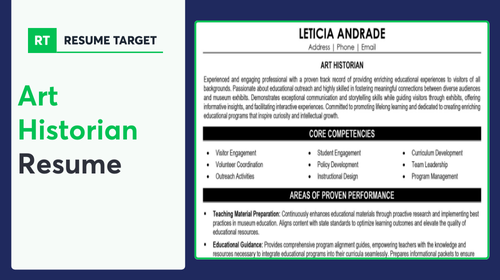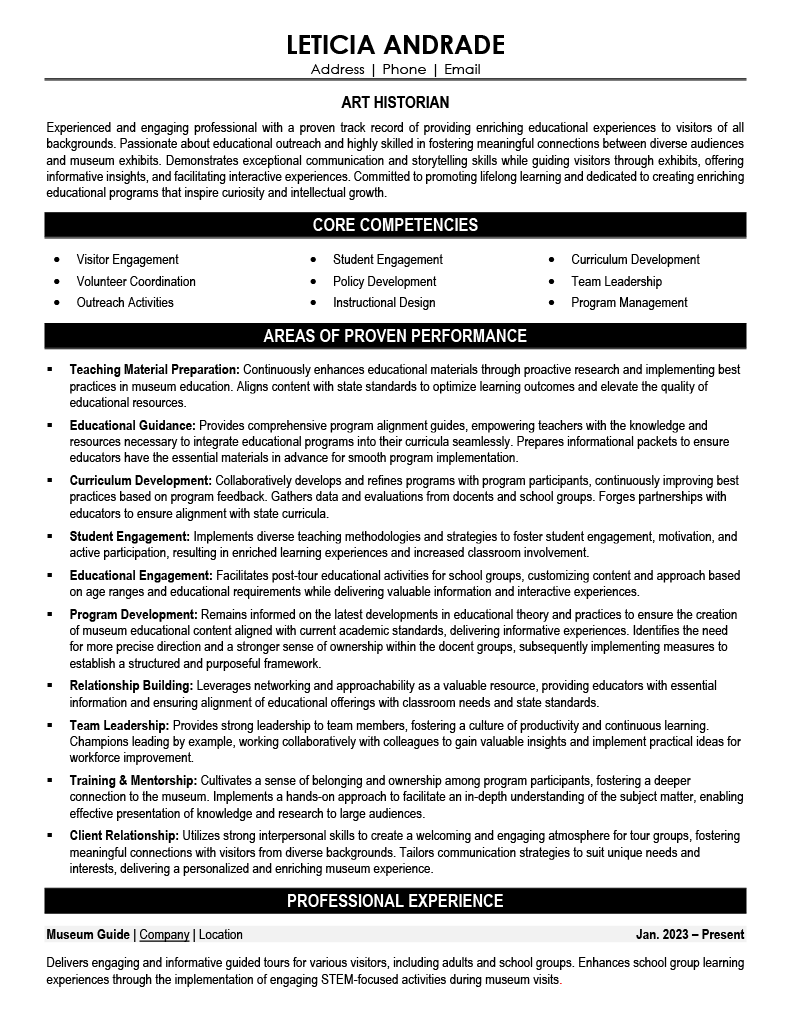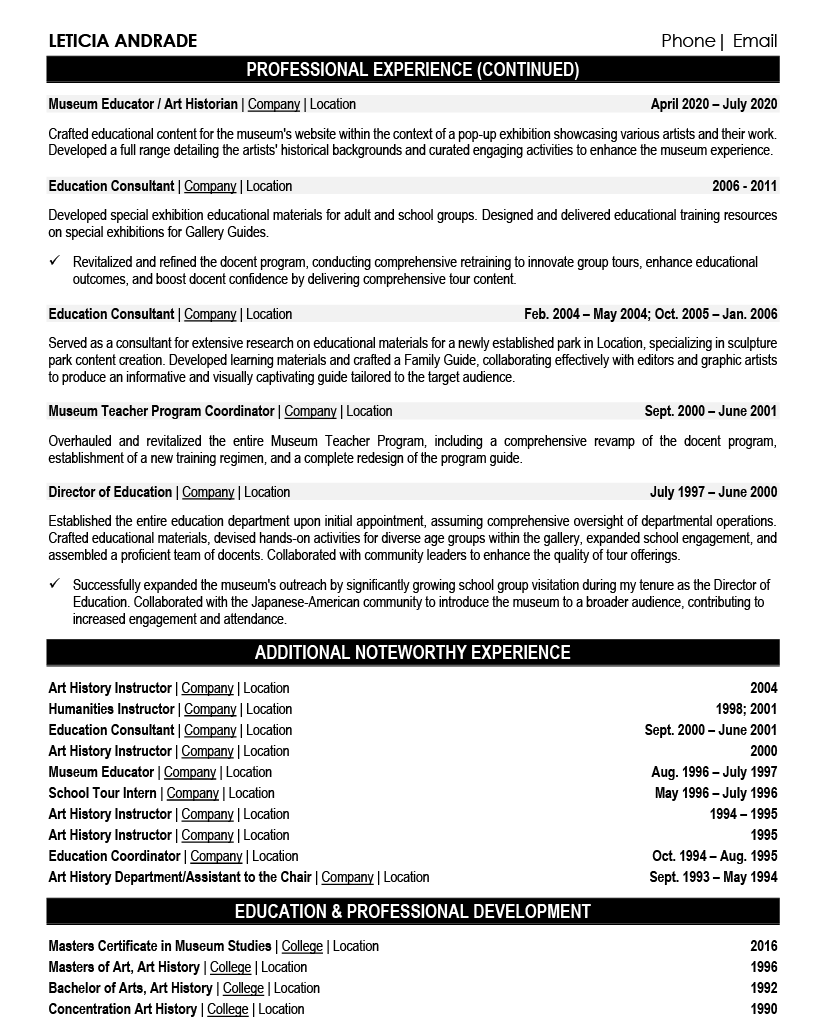

Art historians face a unique challenge: translating deep cultural knowledge into business value. Your expertise in analyzing masterpieces and cultural movements needs to speak to modern employers.
Are you struggling to make your academic background appeal to museums, galleries, and cultural institutions? Your resume needs to bridge the gap between scholarly achievement and practical impact in today's art world.
Resume Target specializes in helping art historians showcase their versatile skills and accomplishments. This guide will transform your academic credentials and research experience into a compelling narrative that captures attention and lands interviews.


Far more than just observers of pretty pictures, art historians are cultural detectives who uncover the hidden stories and historical context behind every artwork and artifact, helping us understand humanity's creative journey through time.
In this fascinating field, you'll find yourself diving deep into research, advising museums and galleries, collaborating with curators to create compelling exhibitions, and sharing your discoveries through publications and presentations that bring art's stories to life.
Whether you dream of curating world-class exhibitions, teaching the next generation of art enthusiasts, or conducting groundbreaking research at historical sites, the path to becoming an art historian offers diverse opportunities to shape how we understand and preserve our cultural heritage.
Let's talk about the exciting earning potential in the Art Historian field! Your passion for art and history can translate into a rewarding career with impressive compensation opportunities, especially as you build expertise and advance in your professional journey.
Figures from: Bureau of Labor Statistics
Start your art history journey in museums or galleries and advance to leadership roles through expertise and experience. Your path can lead from research assistant to museum director or prestigious academic positions.
Beyond basic art knowledge, you'll need a sophisticated blend of analytical, technical, and interpersonal skills to excel in today's competitive museum and academic environments.
- Advanced research methodology and digital archiving - Exhibition design and curation techniques - Grant writing and fundraising expertise - Cultural sensitivity and collaborative leadershipLaunch your art history career by combining a bachelor's degree in art history with hands-on museum internships, developing expertise in specific art periods while building practical gallery and research experience.
To succeed in this field, you'll need to develop key competencies including critical thinking and analysis, which will help you evaluate artworks and their historical significance while advancing through various museum and academic positions.
Requirements from AIBM Institute
From prestigious museums in NYC to academic institutions in DC, art historian roles blend across cultural and educational sectors.
Figures from U.S. Bureau of Labor Statistics
Struggling to translate your passion for art history, curatorial experience, and research skills into a compelling resume that catches a gallery director's attention? This comprehensive, section-by-section guide will show you exactly how to craft a professional art historian resume that showcases your expertise and achievements.
If you're like most Art Historians, translating your deep knowledge of artistic movements, curatorial experience, and research abilities into a compelling resume summary can feel as challenging as authenticating a newly discovered masterpiece.
While you may excel at analyzing artistic techniques and cultural contexts, capturing your expertise in a way that resonates with museum directors, gallery owners, and academic institutions requires a different kind of artistry - one that showcases both your scholarly achievements and practical contributions to the field.
How would you describe your unique perspective on art history and the specific cultural periods or movements where you've developed deep expertise?
Reason: This helps establish your specialized knowledge area and scholarly focus, immediately signaling to employers your primary value as an Art Historian. It also helps differentiate you from other candidates in the field.
What combination of research methodologies, curatorial experience, and technological tools have you mastered in your art historical practice?
Reason: This question helps articulate your professional toolkit and demonstrates how you bridge traditional art historical practices with modern analytical approaches, showing your adaptability and comprehensive skill set.
How do you typically connect art historical knowledge with broader institutional goals, whether in academia, museum settings, or cultural organizations?
Reason: This helps frame your ability to translate scholarly expertise into practical value, showing potential employers how your work contributes to their organization's mission and objectives.
As an Art Historian, you need to demonstrate both your deep scholarly expertise and practical museum or gallery-related capabilities on your resume.
Your skills should reflect a blend of academic prowess (like period-specific knowledge and research methodology) alongside hands-on abilities such as collection management, exhibition planning, and digital archive systems.
Showcase your expertise in art analysis, research, and curation by organizing your professional experience into three powerful sections: a compelling role overview, quantifiable achievements in exhibition development or research publications, and core responsibilities that highlight your specialized knowledge of art periods and preservation techniques.
Many Art Historians struggle to translate their deep academic knowledge and curatorial experience into concrete, business-focused accomplishments. Transform your scholarly work and exhibitions into measurable impacts by connecting your research, publications, and curatorial projects to increased museum attendance, successful grant acquisitions, and enhanced institutional visibility.
The responsibilities section demonstrates how Art Historians contribute beyond basic research and cataloging tasks. Your role requires translating complex artistic concepts into clear narratives while connecting historical artwork to broader cultural contexts and institutional goals.
Your academic credentials and specialized art history certifications demonstrate your expertise in analyzing and interpreting artistic works across different periods. Prioritize your highest degree in Art History or related field first, followed by any museum studies certificates or specialized training in conservation and curatorial practices.
Now that you've crafted a strong foundation using Resume Target's expert guidelines, you're ready to transform your base resume into a powerful tool for landing your dream art historian position.
While many candidates focus solely on customizing their cover letters, tailoring your resume for specific art historian roles - whether in museums, universities, galleries, or research institutions - is equally crucial for standing out in this competitive field.
A strategically customized resume not only helps you navigate through ATS systems by incorporating role-specific keywords, but it also demonstrates to hiring managers your precise alignment with their institution's focus, whether it's contemporary art, classical antiquities, or specific cultural periods.
Ready to turn your resume into a masterpiece? Let's transform your credentials into a compelling narrative that showcases you as the perfect curator of your own career success!
Don't let a lack of formal experience hold you back from pursuing your dream career as an Art Historian!
Your academic background, research projects, and museum internships can create a compelling narrative that showcases your potential in the field.
Focus on highlighting your art historical knowledge, research capabilities, and analytical skills while incorporating any relevant coursework or cultural institution experience.
For more detailed guidance on structuring your academic achievements and internship experiences, check out the Student Resume Writing Guide.
Your art history education and research experience are powerful assets that deserve to be showcased front and center in your resume summary.
Focus on highlighting your specialized knowledge, research capabilities, and any hands-on experience with collections, exhibitions, or cultural institutions to create an engaging narrative.
"Detail-oriented and culturally astute Art History graduate with comprehensive academic training in Western and Non-Western art movements, curatorial practices, and archival research. Completed two museum internships focusing on collection management and exhibition planning, while maintaining a 3.9 GPA in specialized coursework. Demonstrated expertise in digital art databases and collection management software through successful cataloging of 200+ artifacts. Seeking to leverage strong analytical and research capabilities to contribute meaningful insights as an entry-level Art Historian."
Now's your chance to showcase the depth of your art historical knowledge and research capabilities through a compelling education section that highlights your academic journey!
Transform your coursework into engaging content by featuring specialized seminars, research projects, and thesis work - for example, highlight that graduate seminar on Renaissance painting techniques or your original research on women artists in the Baroque period.
Courses common to an Art History degree include a wide variety of Art History courses, spanning many different cultures, geographies, time periods, and artistic styles [1]. The Art History major requires a minimum of nine courses [2]. Art history coursework delves into visual, material, and textual expressions of culture and our place within it, covering a range of regions and topics [3]. Majors must take a minimum of 4 credits in fine arts [4]. Online Art History courses include Modern and Contemporary Art and Design, Modern Art & Ideas, The Modern World, Part One: Global History from 1760 to 1910, Introduction to Ancient Egypt and Its Civilization, and Roman Art and Archaeology [5].Relevant Coursework: Modern and Contemporary Art | Ancient Egypt Civilization | Roman Art and Archaeology | Global Art History | Visual Culture Analysis | Art Theory & Criticism
Key Projects:
Digital Archive Curation Project: Developed a comprehensive digital exhibition focusing on post-war European art movements, creating an accessible online platform for academic research and public engagement.
Renaissance Art Research Symposium: Coordinated and presented at a student-led symposium examining the influence of Mediterranean trade routes on 15th-century Italian painting techniques.
Transform your academic knowledge and research experience into compelling professional skills by highlighting your expertise from coursework, museum internships, and hands-on projects with historical artifacts and collections.
As an aspiring Art Historian, your unique combination of analytical, technical, and creative skills positions you well for roles in museums, galleries, educational institutions, and cultural organizations, where the demand for fresh perspectives in art historical research and curation continues to grow.
Let's face it - translating your deep knowledge of artistic movements, curatorial experience, and research expertise into compelling resume content can feel like describing a Picasso in just three words.
At Resume Target, we specialize in crafting resumes for art history professionals that capture both your academic credentials and practical impact in the field.
Our team has helped countless art historians showcase their unique blend of analytical skills and creative insights, transforming complex exhibition experiences and research publications into powerful career narratives that resonate with museums, galleries, and educational institutions.
With museums and cultural institutions actively seeking fresh perspectives, now is the perfect time to ensure your resume reflects your true value - let's connect today to craft a resume that makes your expertise shine.
Impress any hiring manager with our arts resume writing service. We work with all career levels and types of arts professionals.
Learn More → Arts Resume Writing Services